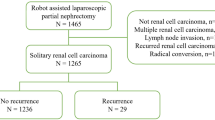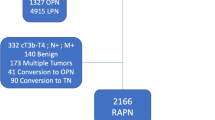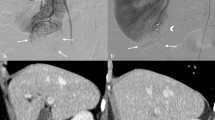Abstract
In addition to an increased occurrence of small, localized, incidentally discovered renal cell carcinomas (RCCs), there has been an upward trend in the incidence of advanced renal tumors per unit of population and in disease mortality worldwide. As radical nephrectomy remains the standard of care in treating localized RCC, this manuscript focuses on surgical approaches. We defined 'large renal tumors' as those greater than 7 cm or those with venous involvement. We discuss operative strategies in both open and laparoscopic surgery as well as approaches to special circumstances, including patients with tumor thrombus and the indications for nephron-sparing surgery in patients with greater than T2 RCC. The literature pertaining to controversial areas such as preoperative renal artery embolization and the clinical utility of metastectomy and cytoreductive therapy are also reviewed. The theoretical basis and potential applications of neoadjuvant therapy for larger renal tumors is examined as well.
Key Points
-
In addition to an increased incidence of asymptomatic localized RCC, there has also been an upward trend in advanced tumors per unit population and in disease mortality
-
Familiarity with both anterior and flank/thoracoabdominal incisions is paramount in maximizing exposure of the kidney and minimizing morbidity in patients with large renal tumors
-
Venous tumor involvement is a distinct scenario that should be managed by a multidisciplinary team at a tertiary care center; tumor thrombus at or above the level of the hepatic veins mandates venovenous bypass and can be performed via a minimal access technique
-
Initial results on laparoscopic radical nephrectomy in select patients with T2 or greater disease have been encouraging. An intraperitoneal approach is generally preferred
-
Only under extenuating circumstances, such as bilateral synchronous tumors or a solitary kidney, should partial nephrectomy be considered in patients with large renal tumors
-
Cytoreductive therapy and neoadjuvant therapy are developing modalities that might become further used with the progression of molecular targeted therapies
This is a preview of subscription content, access via your institution
Access options
Subscribe to this journal
Receive 12 print issues and online access
$209.00 per year
only $17.42 per issue
Buy this article
- Purchase on Springer Link
- Instant access to full article PDF
Prices may be subject to local taxes which are calculated during checkout






Similar content being viewed by others
References
Jemal A et al. (2005) Cancer statistics. CA Cancer J Clin 55: 10–30
Chow WH et al. (1999) Rising incidence of renal cell cancer in the United States. JAMA 281: 1628–1631
Hock LM et al. (2002) Increasing incidence of all stages of kidney cancer in the last decades in the United States: an analysis of surveillance, epidemiology and end results program data. J Urol 167: 57–60
Lam JS et al. (2006) Long-term outcomes of the surgical management of renal cell carcinoma. World J Urol 24: 255–266
Guinan PD et al. (1995) Renal cell carcinoma: tumor size, stage and survival. Members of the Cancer Incidence and End Results Committee. Urology 153: 901–903
Kinouchi T et al. (1999) Impact of tumor size on the clinical outcomes of patients with Robson stage I renal cell carcinoma. Cancer 85: 689–695
Javidan J et al. (1999) Prognostic significance of the 1997 TNM classification of renal cell carcinoma. J Urol 162: 1277–1281
Tsui KH et al. (2000) Prognostic indicators for renal cell carcinoma: a multivariate analysis of 643 patients using the revised 1997 TNM staging criteria. J Urol 163: 1090–1095
Gettman MT et al. (2001) Pathologic staging of renal cell carcinoma: significance of tumor classification with the 1997 TNM staging system. Cancer 91: 354–361
Tsui KH et al. (2000) Renal cell carcinoma prognostic significance of incidentally detected tumors. J Urol 163: 426–430
Scheft P et al. (1978) Surgery for renal cell carcinoma extending into the vena cava. J Urol 120: 28–31
Heidenreich A and Ravery V (2004) Preoperative imaging in renal cell cancer. World J Urol 22: 307–315
Huang GJ et al. (2004) Preoperative renal tumor evaluation by three-dimensional magnetic resonance imaging: staging and detection of multifocality. Urology 64: 453–457
Oto A et al. (1998) Inferior vena cava tumor thrombus in renal cell carcinoma: staging by MR imaging and impact on surgical. Am J Roentgenol 171: 1619–1624
Ramdave S et al. (2001) Clinical role of F-18 fluorodeoxyglucose positron emission tomography for detection and management of renal cell carcinoma. J Urol 166: 825–830
Lawrentschuk N et al. (2006) Positive emission tomography, immuno-PET and radioimmunotherapy in renal cell carcinoma: a developing diagnostic and therapeutic relationship. BJU Int 97: 916–922
Zielinski H et al. (2000) Comparison of preoperative embolization followed by radical nephrectomy with radical nephrectomy alone for renal cell carcinoma. Am J Clin Oncol 23: 6–12
Nakano H et al. (1983) Treatment of renal cancer patients by transcatheter embolization and its effects on lymphocyte proliferative responses. J Urol 130: 24–27
Bakke A et al. (1982) Augmentation of natural killer cell activity after arterial embolization of renal carcinomas. Cancer Res 42: 3880–3883
Schwartz MJ et al. (2006) Renal artery embolization: clinical indications and experience from over 100 cases. BJU Int 99: 881–886
Robson CJ et al. (1969) The results of radical nephrectomy for renal cell carcinoma. J Urol 101: 297–301
Risk ES et al. (2000) Embryology, anatomy, and surgical applications of the kidney and ureter. Surg Clin North Am 90: 381–397
Antonelli A et al. (2006) Surgical treatment of adrenal metastasis from renal cell carcinoma: a single-centre experience of 45 patients. BJU Int 97: 505–508
Lam JS et al. (2006) Evolving principles of surgical management and prognostic factors for outcome in renal cell carcinoma. J Clin Oncol 24: 5565–5575
Han K-R et al. (2003) TNM T3A renal cell carcinoma: adrenal gland involvement is not the same as renal fat invasion. J Urol 169: 899–904
Tsui KH et al. (2000) Is adrenalectomy a necessary component of radical nephrectomy: UCLA experience with 511 radical nephrectomies. J Urol 163: 437–441
Paul R et al. (2001) Adrenal sparing surgery during radical nephrectomy in patients with renal cell cancer: a new algorithm. 166: 59–62
Blom JH et al. (1999) Radical nephrectomy with and without lymph node dissection: preliminary results of the EORTC randomized phase III protocol 30881-EORTC Genitourinary Group. Eur Urol 36: 570–575
Glazer AA and Novick AC (1996) Long-term follow-up after surgical treatment for renal cell carcinoma extending into the right atrium. J Urol 155: 448–450
Zisman A et al. (2003) Renal cell carcinoma with tumor thrombus extension: biology, role of lymphadenectomy and response to immunotherapy. J Urol 169: 909–916
Moinzadeh A and Libertino JA (2004) Prognostic significance of tumor thrombus level in patients with renal cell carcinoma and venous tumor thrombus extension. Is all T3b the same? J Urol 171: 598–601
Kim HL et al. (2004) Prognostic significance of venous tumor thrombus in renal cell carcinoma. Are renal vein and inferior vena cava involvement different? J Urol 171: 588–591
Leibovich BC et al. (2005) Cancer specific survival for patients with pT3 renal cell carcinoma—can the 2002 Primary Tumor Classification be improved? J Urol 173: 716–719
Blute ML et al. (2004) The Mayo Clinic experience with surgical management, complications and outcome for patients with renal cell carcinoma and venous tumour thrombus. BJU Int 94: 33–41
Boorjian SA et al. (2007) Renal cell carcinoma: vena caval involvement. BJU Int 99: 1239–1244
Wotkowicz C et al. (2006) Management of renal cell carcinoma with vena cava and atrial thrombus: minimal access vs median sternotomy with circulatory arrest. BJU Int 98: 289–297
Ciancio G et al. (2007) Surgical management of renal cell carcinoma with tumor thrombus in the renal and inferior vena cava: the University of Miami experience in using liver transplantation techniques. Eur Urol 51: 988–994
Dunn MD et al. (2000) Laparoscopic versus open radical nephrectomy: a 9 year experience. J Urol 164: 1153–1159
Portis AJ et al. (2002) Long-term followup after laparoscopic radical nephrectomy. J Urol 167: 1257–1262
Chan DY et al. (2001) Laparoscopic radical nephrectomy: cancer control for renal cell carcinoma. J Urol 166: 2095–2099
Ono Y et al. (2001) The long-term outcome of laparoscopic radical nephrectomy for small renal cell carcinoma. J Urol 165: 1867–1870
Steinberg AP et al. (2004) Laparoscopic radical nephrectomy for larger (>7 cm, T2) renal tumors. J Urol 172: 2172–2176
Hemal AK et al. (2007) Laparoscopic versus open radical nephrectomy for large renal tumors: a long-term prospective comparison. J Urol 177: 862–866
Gong EM et al. (2006) Laparoscopic radical nephrectomy: comparison of clinical stage T1 and T2 renal tumors. Urology 68: 1183–1187
Lau WK et al. (2000) Matched comparison of radical nephrectomy vs nephron sparing surgery in patients with unilateral renal cell carcinoma and a normal contralateral kidney. Mayo Clin Proc 75: 1236–1242
Clark PE et al. (2001) Quality of life and psychological adaptation after surgical treatment for localized renal cell carcinoma: impact of the amount of remaining renal tissue. Urology 57: 252–256
Lee CT et al. (2000) Surgical management of renal tumors 4 cm or less in a contemporary cohort. J Urol 163: 730–736
Leibovich BC et al. (2004) Nephron sparing surgery for appropriately selected renal cell carcinoma between 4 and 7 cm results in outcome similar to radical nephrectomy. J Urol 171: 1066–1070
Becker F et al. (2006) Excellent long-term cancer control with elective nephron-sparing surgery for selected renal cell carcinomas measuring more than 4 cm. Eur Urol 49: 1058–1064
Ukimura O et al. (2006) Laparoscopic partial nephrectomy for incidental pT2 or worse tumors. J Urol 68: 976–981
Wotkowicz C and Libertino JA (2007) Renal cell cancer: radical nephrectomy. BJU Int 99: 1231–1238
Rouviere O et al. (2006) Nonmetastatic renal cell carcinoma: is it really possible to define rational guidelines for post-treatment follow-up? Nat Clin Pract Oncol 3: 200–213
Lam JS et al. (2004) Advances in immune-based therapies of renal cell carcinoma. Expert Rev Anticancer Ther 4: 1081–1096
Flanigan RC et al. (2004) Cytoreductive nephrectomy in patients with metastatic renal cancer: a combined analysis. J Urol 171: 1071–1076
Wagner JR et al. (1999) Interleukin-2 based immunotherapy for metastatic renal cell carcinoma with the kidney in place. J Urol 162: 43–45
Ratain MJ et al. (2006) Phase II placebo-controlled randomized discontinuation trial of sorafenib in patients with metastatic renal cell carcinoma. J Clin Oncol 24: 2505–2512
Escudier B et al. (2005) Randomized Phase III trial of raf kinase and VEGFR inhibitor sorafenib in patients with advanced renal cell carcinoma. Proc Am Soc Clin Oncol 23: 4510
Motzer RJ et al. (2006) Sunitinib in patients with metastatic renal cell carcinoma. JAMA 295: 2516–2524
Motzer RJ et al. (2006) Activity of SU11248, a multitargeted inhibitor of vascular endothelial growth factor receptor and platelet derived growth factor receptor, in patients with metastatic renal cell carcinoma. J Clin Oncol 24: 16–24
Rini BI and Campbell SC (2007) The evolving role of surgery for advanced renal cell carcinoma in the era of molecular targeted therapy. J Urol 177: 1978–1984
Author information
Authors and Affiliations
Corresponding author
Ethics declarations
Competing interests
The authors declare no competing financial interests.
Rights and permissions
About this article
Cite this article
Wszolek, M., Wotkowicz, C. & Libertino, J. Surgical management of large renal tumors. Nat Rev Urol 5, 35–46 (2008). https://doi.org/10.1038/ncpuro0963
Received:
Accepted:
Issue Date:
DOI: https://doi.org/10.1038/ncpuro0963
This article is cited by
-
Renal artery embolization—indications, technical approaches and outcomes
Nature Reviews Nephrology (2015)
-
IVC Thrombectomy in Renal Cell Carcinoma—Analysis of Out Come Data of 100 Patients and Review of Literature
Indian Journal of Surgical Oncology (2012)
-
Treatment options in localised and metastatic renal cell carcinoma
memo - Magazine of European Medical Oncology (2008)



